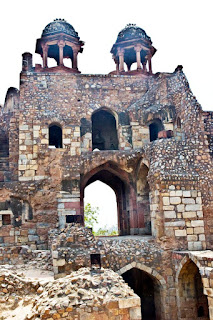Chandni Chowk is one of the oldest and busiest markets of Delhi since the times of Mughal Emperor Shahjahan when he founded the city of Shahjahabad in the mid 17th century. Jahanara, the favourite daughter of Shahjahan is said to have laid its foundation. It stretches from the Lahore Gate of the Red fort to the Fatehpuri Masjid. In early times it was divided into 5 katras. The Urdu bazaar extended from the Digambar Jain temple or the Lal Mandir as it is know for the red stones it is made of to Dariba. The Phool Mandi stretched from Dariba Kalan to the royal police station called Kotwali. From Kotwali till the present Town Hall, the area was called Ashrafi bazaar. The fourth part was known as Chandini Chowk, which extended from Ashrafi bazaar till the Fatehpuri Masjid. And the fifth part consisted of Jama Masjid and Matia Mahal.
The stretch from Lahore Gate to the Fatehpuri Masjid is surrounded in the South and West by many other wholesale markets like Nai Sarak, where one can buy text books by any author on any subject. Chawri Bazaar the wholesale market for any kind of paper and also the famous hub of printing of invitation cards for weddings. The market is also famous for brass and copper works. Chawri Bazaar now also has a station of the Delhi Metro Train that runs underground from the Central Secretariat to Delhi University. The station has the distinction of being the deepest station of the Delhi Metro (70 ft. below the ground!). The next Metro station on this line in this vicinity is that of Chandni Chowk.
Kinari Bazaar is another famous market to shop for anything required for a wedding. The Bazaar winds through a crowded and dimly lit alley with openings at Dariba Kalan and Parathe Wali Gali famous for its shops making parathas since the time of Shahjahan. The shops in Kinari Bazaar sell large stocks of sehras (groom’s turban), garlands made beautifully from gold and silver tinsel and crisp currency notes, bridal jewelery and other accessories required during a wedding ceremony. The shops cater to the needs of people belonging to mostly all religions. Even wedding clothes can also be hired from these shops like bridal veil, attractively designed lehengas, gold brocade Sherwanis and anything or everything that one requires in a marriage ceremony.
At the end of the Chandni Chowk besides the Fatehpuri Masjid is the famous whole sale market for spices – the largest in Asia. A cook’s Mecca, the market has shops selling spices, dry fruits, pickles, murabbas, paapads apart from wheat, rice and lentils.
Within the markets, the area of Chandni Chowk is swelled by residences known as Kuchas (alleys) and Gallis (by-alleys). Winding through these gallis one can come across many old havelis dating back to late 18th century. Ballimaran, one of the famous alleys of Chandni Chowk has a haveli in the Gali Qasim Jaan where the famous urdu poet Mirza Ghalib (1796-1869) of the Last Mughal Emperor, Bahadur Shah Zafar’s time, lived from prior to 1857 till the last phase of his life. A portion of the haveli has now been acquired by the government and converted into a memorial in the memory of the famous poet.
As the city of Shahjahanbad was a fortified city, it had a wall surrounding the city for safety and protection. Hence, till now it is known as the Walled City of Delhi. The city had many gates known by the names of the direction of the other cities they opened to. Like the Lahore Gate opened to the direction of Lahore, now in Pakistan, similarly, the Delhi Gate, Cabul Gate, Mori Gate, Turkman Gate, Kashmiri Gate, Ajmeri Gate.
Chandi Chowk was plundered in 1739 by Nadir Shah who came from Iran to invade the Mughals in India. He witnessed the plunder from Sunehri Masjid outside Chandi Chowk. 30,000 people were killed and Nadir Shah carried away with him, the famous Peacock Throne and the Koh-i-Noor diamond as a part of the looted booty.
Chandni Chowk has also the distinction of having the number of religios places of the various religions in India. The Jama Masjid, Digamber Lal Jain Temple, The Gauri Shankar Temple, The Sisganj Gurudwara and The Central Baptist Church. All these religious places are within the 2 kms. stretch from Lahore Gate to the Fatehpuri Masjid.
When the Postal Department set up the codes for the cities, the Walled City of Chandni Chowk was alloted ‘6’ as the postal code. Since then it is also known as “Dilli Chhe” (Delhi-6)
TO GO BACK CLICK HERE

